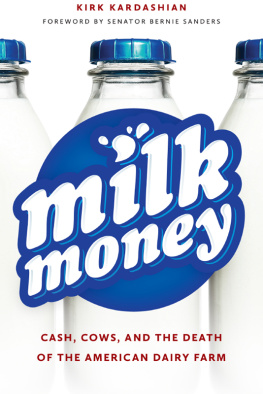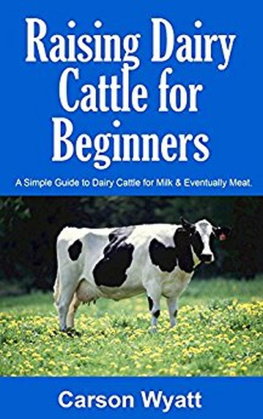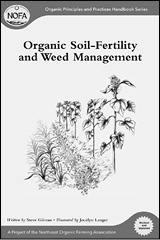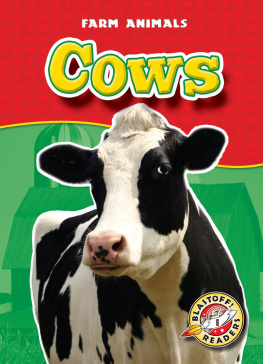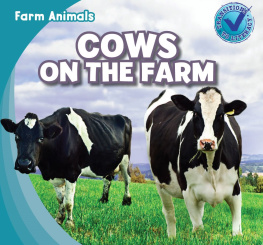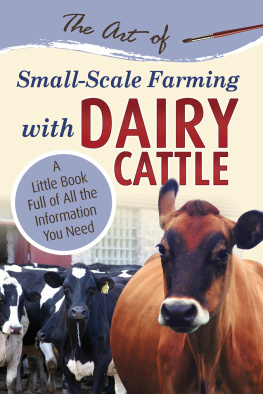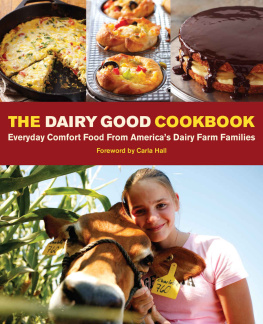PREFACE
I wrote this book because of an irksome incongruity. In the spring of 2009 I was driving my daughter eight miles every morning to daycare, and on the way I would listen to Morning Edition and the local news on Vermont Public Radio. Almost every day, it seemed, there was one story or another on the so-called dairy crisis and its impact on farms and communities. As an average consumer of milk, cheese, yogurt, and butter, I listened with a somewhat aloof curiosity about the drop in farmers revenues, the increases in grain prices, the volatility of the global milk market, and the accelerating decline in the number of dairy farms around the country. And then I arrived at my destination, a private daycare in a house on a small dairy farm, and everything I heard on the radio simultaneously angered me and made no sense at all.
Inside that house lived Russell and Mary, their twenty-something son Ryan, and a big, lazy, yellow Labrador retriever named Caleb. Outside, on the pastures, lived seventy black and white cows. On the farm, the men do the milking and the cropping, and Mary cares for the newborn calves. On the side, Russell and Ryan boil sap into maple syrup and plow driveways, while Mary cares for neighborhood kids. They have served on the town select board and school board. They are members of long-standing community organizations that hold annual suppers. In the summer, at the edge of the quiet dirt road that cuts through their farm, they stock a small shed with home-grown corn, cucumbers, and tomatoes. It operates with a price sheet, a metal money box, and the honor system. Arriving in their kitchen on the weekdays at 7:30, I got to know these folks fairly well. By that time, Russell would be in his slippers, eating breakfast and reading the paper, having been up since 4:30. Ryan, tall, skinny, and laconic, would be in the dining room, shoveling cereal into his mouth and watching Good Morning America. And Mary would be rinsing the fresh chicken eggs at the sink and putting them in reused cartons to sell. These people struck me, a child of suburban New Jersey, as rugged, rural America incarnate; the best of our national DNA.
Carrying the bitter taste of the radio stories through the squeaky screen door and into the diurnal rhythms of a struggling dairy family proved a potent tonic. Its effect was to make me think Big Thoughts. I wondered how it could be that such honest, hardworking people could produce a nutritious food almost everyone consumes, and do it well, yet lose money. It seemed wrong that, in this greatest of meritocracies, the faithful could deposit their capital, sweat equity, and skill into the market and emerge on the other side with a debit instead of a credit. Surely, I reasoned, there must be a logical explanation.
The newspaper reports did their job, up to a point. They assembled the relevant statistics, plugged in the voices of the analysts and the aggrieved, and hit the refresh button every couple of days. They told of a melamine scare in China that deflated global demand, the rise of ethanol that made food compete against fuel, and a solipsistic milk machine that knew just one setting: more. They counted the thousands of farms that had disappeared in places as diverse as California, Vermont, and Wisconsin. There were heart-wrenching human-interest stories about farmers who killed themselves because of the financial stress, of farm-equipment auctions on sixth-generation farms, of communities left wondering what they really stood for anymore. Without intending it, these dispatches were forming pieces of a mosaic that depicted a country and a culture undergoing revolutionary change.
What was lacking, in my view, was a grand narrative that explored the larger questions few others seemed to be asking. I wanted to know how the dairy industry had arrived at its current location, a place where cows increasingly dont graze on pastures and farms increasingly resemble factories. I wanted to uncover the implications of that journeyfrom grass to concrete, from farm to factoryon people, animals, and the environment. And I wanted to know how we might navigate to a place more just, prosperous, and sustainable. This book is my attempt at some answers. Though this is a work of nonfiction, some names have been changed to protect the privacy of those who agreed to speak on the record.
Like many other books that have come before it, this is a piece of consciousness-raising journalism. Our world has grown so complex that we no longer appreciate how our food is made, and the impacts our purchases have on our society. The scale of food production today is so large, and our lives so detached from the lives of farmers, that its easy to assume our individual food choices are meaningless. But thats not true. If consumption is akin to voting, then today we are largely voting for a system that values efficiency over quality, and low, low prices over a healthy environment, fair wages, animal dignity, and robust communities. Changing the system might be as easy as changing your vote.
ACKNOWLEDGMENTS
I first uttered my idea for this book to my friend Tom Zoellner on a quiet evening on the Dartmouth quad. An author himself, he paid no mind to the fact that Id never before written a book. Instead he talked me through it, gave me encouragement and technical advice, and, most important, believed in me. This book might not have been possible without Toms help.
Another person who believed in me was my agent, Jennifer Griffin. Throughout the process shes been kind, straight-talking, and tenacious. I cant thank her enough.
Im also grateful for the patience and fine counsel of my editor at UPNE, Stephen Hull. Hes one more person who, perhaps against the odds, believed I could write this book.
Along the way, lots of friends, family, and colleagues have offered crucial support in numerous ways. These people have included Joe Olshan, Deidre Heekin, Joni Praded, Alan Weisman, John Seabrook, Bill McKibben, Garret Keizer, Barry Estabrook, Chad DeChow, Doug and Patty Reaves, Todd and Carole Stall, Jane Kardashian and Vatche Soghomonian, Paul and Sherry Doton, Elizabeth Reaves, Michael Zsoldos, Theo Padnos, Ephraim Camacho and the people at California Rural Legal Assistance, and Lupe Martinez, Brent Newell, and the people at the Center on Race, Poverty and the Environment.
I owe the largest debt of gratitude to my wife, Kate, for giving me the time and encouragement I needed to write this book. Shes been a saint.
Finally, Id like to thank my parents for, well, just about everything imaginable.
BIBLIOGRAPHY
Anderson, Virginia DeJohn. Creatures of Empire: How Domestic Animals Transformed Early America. Oxford: Oxford University Press, 2004.
Arax, Mark, and Rick Wartzman. The King of California: J.G. Boswell and the Making of a Secret American Empire. New York: Public Affairs Books, 2003.
Bakken, Henry H., and Marvin A. Scharrs. The Economics of Cooperative Marketing. New York: McGraw Hill, 1937.
Barker, Graeme. The Agricultural Revolution in Prehistory: Why Did Foragers Become Farmers? Oxford: Oxford University Press, 2006.
Chandler, Jr., Alfred D., and Bruce Mazlish, eds. Leviathans: Multinational Corporations and the New Global History. Cambridge, UK: Cambridge University Press, 2005.
Cobia, David W., ed. Cooperatives in Agriculture. Englewood Cliffs, NJ: Prentice-Hall, 1989.
Culver, John C., and John Hyde. American Dreamer: A Life of Henry A. Wallace. New York: W. W. Norton and Company, 2000.
Darwin, Charles. The Origin of Species. New York: Penguin, 2003.
Dawn, Karen. Thanking the Monkey: Rethinking the Way We Treat Animals. New York: Harper, 2008.
Delbanco, Andrew. The Real American Dream: A Meditation on Hope

